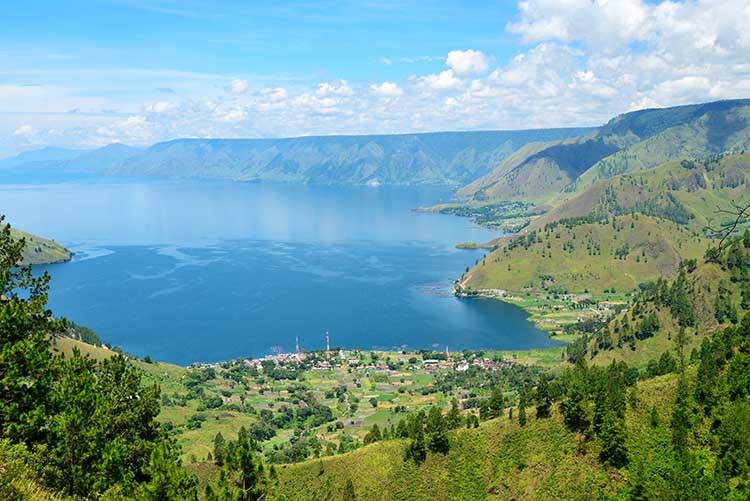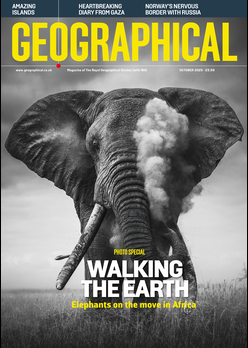
The Toba supervolcano eruption was the most explosive in human history, but debates about its impact on human life are ongoing
Deep within the Indonesian island of Sumatra lies a sleeping giant: the Toba supervolcano. It is responsible for the largest known explosive eruption in human history, which took place 74,000 years ago. Debates about the impact of this explosion continue today. Meanwhile, volcanologists analyse markers and signs of future activity.
A supervolcano erupts
Toba is one of 20 supervolcanos on Earth today, the most famous being Yellowstone in the USA. A supervolcano is one that, at some point in history, released more than 1,000 cubic kilometres of magma during an eruption (a ‘supereruption’). This is also known as an eruption of magnitude 8 on the Volcano Explosivity Index.
Visitors to the site of the Toba supervolcano in Sumatra today will find mostly water. The volcano’s caldera (the large cauldron-like hollow that forms shortly after the emptying of a magma chamber in a volcanic eruption) is home to the largest volcanic lake on Earth, measuring about 100 kilometres long, 30 kilometres wide, and up to 505 metres deep. The lake is recognised as a GeoPark by UNESCO.
Toba’s huge caldera was formed 74,000 years ago when the supervolcano that lies beneath exploded in the biggest eruption of the past 28 million years. This eruption was vast, resulting in a crater visible from space. It is estimated that around 2,800 cubic kilometres of volcanic ash and lava were thrown into the atmosphere, 12% more than was ejected by the last Yellowstone eruption of 2.2m years ago.
Parts of Indonesia, India and the Indian Ocean were covered by 15 centimetres of volcanic debris. The eruption likely caused severe climate disruption in many areas of the globe. Before this, the volcano erupted 840,000 years ago in a similarly massive way.
Toba Catastrophe Theory
Debates about the impacts of the most recent Toba supereruption on early human populations are ongoing, although one famous theory has now been largely debunked. The theory, called the Toba Catastrophe Theory suggested that the eruption led to a volcanic winter big enough to wipe out most early humans.
Volcanic winters occur when ash and volcanic gases released by an eruption into the atmosphere partially block the sunlight, resulting in a drop in global temperature. The Toba Catastrophe Theory linked the eruption to genetic evidence that suggests there was a steep drop in the human population around this time – a ‘genetic bottleneck’ that may have resulted in a surviving population of only 3,000–10,000 individuals.

More recent research, however, has cast doubt on the idea that early humans were almost wiped out by Toba’s volcanic winter. While genetic evidence does suggest a severe drop in human numbers around this time, other reasons, including migration out of Africa, could have been responsible.
Nevertheless, recent studies are still providing intriguing evidence as to the ways humans were forced to adapt to conditions caused by the volcano. One study at an archaeological site in northwest Ethiopia, where a group of early humans known as Shinfa-Metema 1 lived, found that these humans adapted to the arid conditions caused by the volcano.
By piecing together clues from the fossils and artefacts found at the site, along with geological and molecular analysis, the team proposed that the Shinfa-Metema 1 shifted their diets, in particular, eating more fish. The theory is that fish would have been readily harvested from shallow waterholes, which occurred due to the drying of Shinfa River.
Another recent study utilises climate modelling to suggest that rather than a worldwide drop in temperature as a result of the eruption, there were likely significant regional variations. This study suggests that there were much harsher impacts in the Northern Hemisphere than in the South. As a result, the researchers posit that the eruption had only modest effects on the development of hominid species in Africa.
Toba today
Scientists know that Toba has erupted at least twice, once 840,000 years ago and again 75,000 years ago, as documented above. Today, it is classified as active but dormant.
No one knows when Toba will erupt again, and little is known about supervolcanos during dormant periods, which last many thousands of years. In one recent study of the volcano, researchers speculated that Toba’s next major super-eruption is still 600,000 years away, although smaller eruptions could take place in the meantime.

Nevertheless, there were also some more concerning findings, including the fact that such an eruption would be unlikely to be preceded by clear geological signs. The study challenged the established way of studying volcanos, which normally involves looking for liquid magma under a volcano to assess future hazards. Martin Danišík, lead author from Curtin University noted that scientists must consider that eruptions can occur even if no liquid magma is found underneath a volcano, noting that ‘the concept of what is “eruptible” needs to be re-evaluated.’
Ultimately, predicting supereruptions with pinpoint accuracy remains a challenge. Studying past eruptions and analysing volcanic activity offer clues, but a definitive answer to Toba’s future eruptive potential is some way off.




